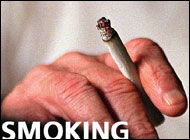Young Smokers Have Quitting on Their Minds
Quitting is on the minds of young smokers well before full-blown addiction sets in, according to a new study from Canada.
“Kids begin to think about quitting very soon after their first puffs,” said lead author Jennifer O’Loughlin, a researcher with the department of social and preventive medicine at the University of Montreal.
The study, which appears in the September issue of the American Journal of Public Health, identified a paradox: Novice smokers, who seem to begin experimenting at the age of 12, continue to escalate their tobacco use while at the same time making several unsuccessful attempts to stop.
During the five-year study, 319 Montreal teenagers filled out questionnaires on their smoking habits every three months. The researchers found that the first serious attempt to quit smoking came just two and a half months after the first puff.
The smoking habit progressed rapidly, with teens taking about nine months to develop a monthly smoking habit, and almost two years to need daily nicotine hits.
As cravings, withdrawal symptoms and tolerance grew, novice smokers began to lose confidence in their ability to quit. After two years, many had discovered that breaking the habit was not so easy. In the course of the study, more than 70 percent of the teens wanted to quit, but only 19 percent actually managed to stop smoking for at least a year.
 “There was evidence to suggest that kids who smoke do want to quit, but the fact that there were so many serious quit attempts two months after initiation is eye opening,” said Geri Dino, director of the Prevention Research Center in the Department of Community Medicine at West Virginia University. Another interesting finding, she said, was that four years after taking up smoking, 32 percent were still unaware of how hard it is to quit: “It’s taking these kids a while to realize this is a tough thing.” Dino had no affiliation with the study.
“There was evidence to suggest that kids who smoke do want to quit, but the fact that there were so many serious quit attempts two months after initiation is eye opening,” said Geri Dino, director of the Prevention Research Center in the Department of Community Medicine at West Virginia University. Another interesting finding, she said, was that four years after taking up smoking, 32 percent were still unaware of how hard it is to quit: “It’s taking these kids a while to realize this is a tough thing.” Dino had no affiliation with the study.
O’Loughlin said the study shows that there are milestones in the process of becoming addicted to tobacco. Understanding the steps that lead to addiction could uncover critical periods when kids might be most open to education and support.
“I think there’s a narrow window of opportunity in there before full-blown addiction that we’re not taking into account in our prevention and cessation interventions aimed at kids,” O’Loughlin said.
The Canadian Cancer Society funded the study.
The American Journal of Public Health is the monthly journal of the American Public Health Association. Visit apha.org for more information. Complimentary online access to the journal is available to credentialed members of the media. Contact Patricia Warin at APHA, (202) 777-2511 or .(JavaScript must be enabled to view this email address).
O’Loughlin J, et al. Milestones in the process of cessation among novice adolescent smokers. Am J Public Health 98(9), 2008.
Source: Health Behavior News Service